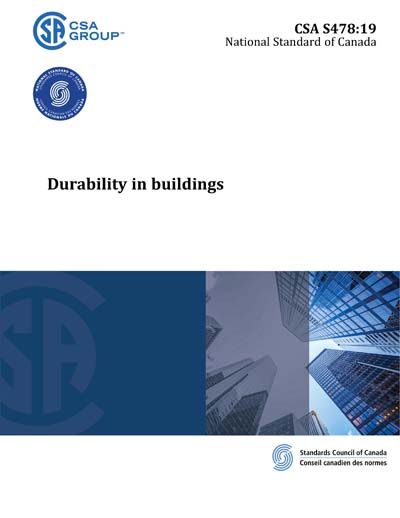Most recent
CSA S478-2019
S478-95 (R2007) - Guideline on Durability in Buildings
Preface This is the second edition of CSA S478, Durability in buildings. It supersedes the first edition, published in 1995 under the title Guideline on Durability in Buildings. The first edition of CSA S478 was issued as a guidance document. This second edition has been developed as a Standard so that it can be referenced in the National Building Code of Canada (NBC). This Standard sets forth minimum requirements to assist designers in creating durable buildings. Annexes to the Standard provide a framework within which the design service life of a building or a building element can be determined and specified. Other annexes to the Standard provide general guidance on the environmental and other design factors that have an impact on the durability of a building, a building material, and/or a building component. The Standard carries forward from its first edition as a guideline an emphasis on the need to consider both initial and long-term costs, maintenance, and replaceability in the selection of materials and components. This Standard is intended to evolve as more information on environmental loads and the impact on building durability becomes available. This Standard was prepared by the CSA Technical Committee on Designing for Durability, under the jurisdiction of the Construction and Civil Infrastructure Strategic Steering Committee, and was formally approved by the Technical Committee. This Standard has been developed in compliance with Standards Council of Canada requirements for National Standards of Canada. It has been published as a National Standard of Canada by CSA Group. Scope 1.1 This Standard provides criteria and requirements for the design of a durable building and its building elements and includes provisions for cost analysis and management and for a quality management program for the design, construction, operation, maintenance, repair, and renovation of a building and its building elements. 1.2 This Standard applies to the building and to building elements that a) are required to resist loads from the structure environment and the effects of those loads; b) are exposed to exterior space or the ground; c) separate interior space from exterior space or separate interior space from the ground; or d) separate environmentally dissimilar interior spaces. 1.3 This Standard includes the following: a) definitions for performance, failure, service life, and other concepts related to the durability of a building or building element; b) fundamental durability requirements for the design of a new building or the repair or renovation of an existing building and building elements; c) compliance criteria for the design for durability of a building and building elements, including requirements for design service life and predicted service life; d) compliance criteria for construction processes that affect durability; e) compliance criteria for quality management and for an operation, maintenance, and inspection program; f) for existing buildings, requirements for investigation and assessment of degradation of a building and building elements and for repair and maintenance; and g) guidance on the use of this Standard to i) select a design service life for a building and building elements; ii) determine a predicted service life; iii) assess structure environments; and iv) understand degradation mechanisms. 1.4 This Standard is intended to be used throughout all stages of the building life cycle, as follows: a) by designers, working from design conception to building handover; b) by building owners, particularly after building handover; c) for operation and maintenance, in conjunction with the designer; and d) for repair and renovation. Note: As a minimum, designers should consult with the building owner from design conception to building handover. The nature of the contract between the designer and the owner might affect the assignment of responsibilities for implementing the Standard after building handover. However, the intent is to ensure seamless transition and effective cooperation and communication between the designer and the owner throughout all stages of the building life cycle to ensure durability and reliability. 1.5 The following are not within the scope of this Standard: a) durability of mechanical systems, electrical systems, and services in buildings; and b) durability of building finishes, except those providing a performance control function. Notes: 1) Although the Standard does not specifically address mechanical systems, electrical systems, and services, such systems and services should be taken into account in an integrated design for durability of a building and building elements. 2) The loads on a building and building elements that result from the operation of mechanical and electrical systems and services should be considered along with the structure environment and structural loads. 1.6 In this Standard, "shall" is used to express a requirement, i.e., a provision that the user is obliged to satisfy in order to comply with the standard; "should" is used to express a recommendation or that which is advised but not required; and "may" is used to express an option or that which is permissible within the limits of the Standard. Notes accompanying clauses do not include requirements or alternative requirements; the purpose of a note accompanying a clause is to separate from the text explanatory or informative material. Notes to tables and figures are considered part of the table or figure and may be written as requirements. Annexes are designated normative (mandatory) or informative (nonmandatory) to define their application.
Content Provider
CSA America, Inc. [csa]






